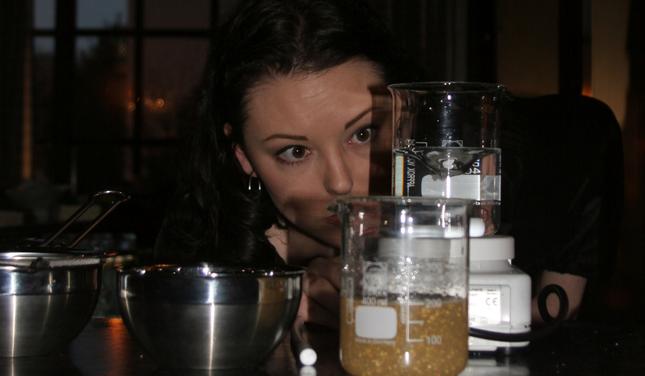Champagne and Pearls
By • November 3, 2011 0 1580

Maybe I should have paid more attention in science class. Chemistry sets, atoms, experiments — these projects tended to bore me when all I could think about was where I was going out Friday night.
But after attending a recent cocktail event sponsored by Cointreau, my interest in science was piqued — mainly because they found a way to combine chemistry and clubbing. It’s called molecular mixology and involves using science to turn a liquid alcohol into a solid. Looking back, if alcohol had been part of my lab days in chem class I would have shown up more often, at least for the samples.
Cointreau experts and Fernando Casellon, a well-known mixologist, harnessed their expertise to turn liquid Cointreau into solid droplets (dubbed Cointreau Pearls). These pearls are created through a scientific molecular mycology process called spherification.
Cointreau hosted a “How are they made” demonstration worthy of the Discovery channel at the newly redesigned St. Regis Hotel bar.
Upon my arrival I was introduced to mixologist Erin Williams, who was busy at work with a stack of lab equipment on the bar. Williams appeared more like a CSI character than bartender as she worked on creating a batch of pearls.
The equipment is part of a highly specialized tool kit provided by Cointreau that includes beakers, a magnetic agitator, syringes, jars of chemicals and the best part: liquor. The St. Regis is the only bar in Washington with this exclusive kit.
On one side of the bar, Erin had had a beaker filled with Cointreau and gold flakes. The edible gold pieces were added to give the finished pearls a glittery appearance. Meanwhile, on the other side of the bar, Erin meticulously mixed another beaker filled with a calcite bath made with Fuji water and a special “sphere gel.”
The actual pearls were formed when Erin dropped the Cointreau mixture, using a syringe, into the calcium solution. The droplets gently formed into tiny solid bubbles that glistened with an orange and golden hue.
I tasted a few of the jellified balls on their own. They had a consistency somewhere between caviar and gummy bears that burst open with an orange rush when bitten.
Next I enjoyed them served with Piper Heidsieck Champagne. The delicate orange spheres danced subtly in the glass along with the Champagne bubbles. The delicate texture of the pearls melded nicely with the crisp sparkling wine.
Cointreau pearls can be customized by bartenders and infused with other flavors. Fruits, herbs, and/or spices simply need to be mixed with the Cointreau before it’s dropped into the calcium bath.
In addition to the Champagne and pearls, two other pearly drinks are featured on the St. Regis’ cocktail menu. The Aphrodite’s Pearl is made with Cointreau pearls infused with cardamom, ginger, nutmeg, and cinnamon, combined with a white wine fortified with tropical fruits and liqueurs. The Acai of Spring features pearls infused with acai berries, cherry-acai vodka and Piper-Heidsieck rose Champagne.
The cocktails were delicious, the overall demonstration entertaining, and I think I actually gained a bit of scientific knowledge. Who knew that drinking could be so educational?
Readers may try Cointreau pearl cocktails at the St. Regis Hotel, located at 923 16th St. Cointreau may be purchased at Dixie Liquor (3429 M St.) in Georgetown.

